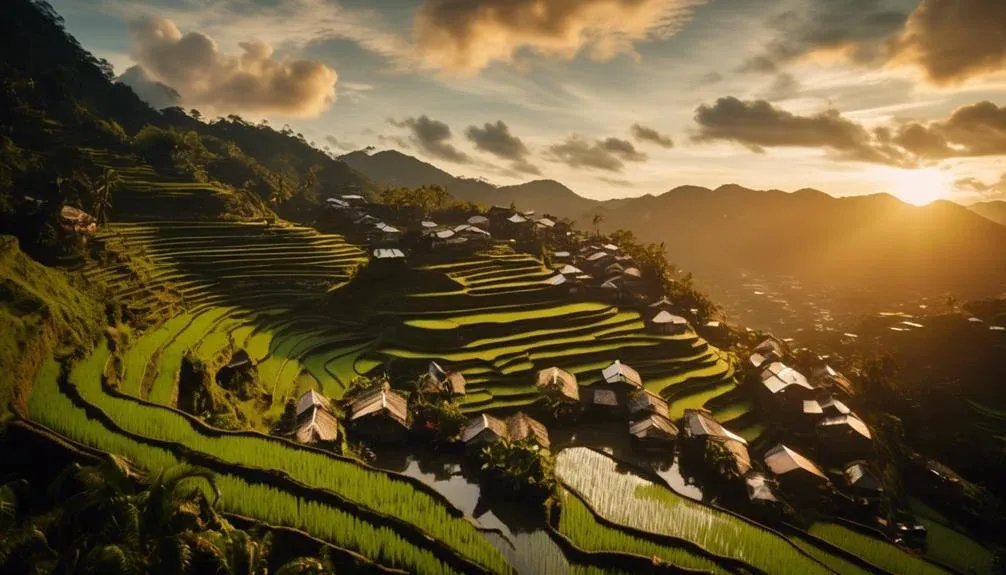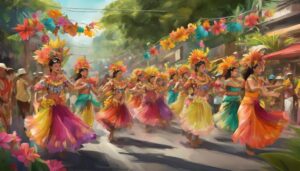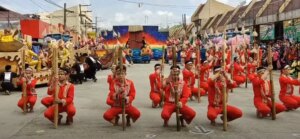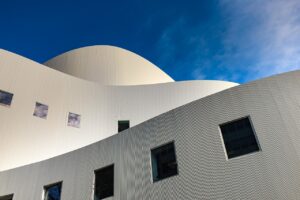
The Philippines boasts several UNESCO sites that showcase the country’s rich history, culture, and natural beauty. These include the Baroque Churches, Banaue Rice Terraces, Vigan, Puerto-Princesa River, and Tubbataha Reefs. Each site offers a unique experience, from exploring colonial streets to marvelling at marine biodiversity.
These UNESCO treasures provide a glimpse into the soul of the Philippines, revealing the country’s resilience, tradition, and innovation.
Key Takeaways
- The Baroque Churches of the Philippines showcase a unique blend of Spanish Baroque and Filipino craftsmanship, with the Earthquake Baroque style developed in response to seismic activity.
- The Banaue Rice Terraces are an ancient agricultural feat and symbol of cultural significance, showcasing a harmonious relationship between humans and the environment.
- Vigan provides a captivating atmosphere through its cobblestone paths, antique houses, and traditional horse-drawn carriage rides, offering an immersive experience in its rich historical and cultural heritage.
- The Underground River of Puerto-Princesa and Tubbataha Reefs highlight the natural wonders of the Philippines, with the former being a marvel of nature and the latter showcasing a vibrant marine ecosystem and important conservation efforts.
Facts About The Philippines’s Historic UNESCO Sites
Following are the facts about the Philippines’ UNESCO World Heritage Sites.
- 🏝️ The Tubbataha Reefs Natural Park, a UNESCO World Heritage Site since 1993, is home to about half of all coral species in the world.
- 🏛️ The Historic City of Vigan, known for its well-preserved Spanish colonial and Asian architecture, is one of the few Hispanic towns left in the Philippines.
- 🌳 The Rice Terraces of the Philippine Cordilleras, over 2,000 years old, are a testament to ancient and sustainable farming practices, carved mostly by hand into the mountains.
- ⛪ The Baroque Churches of the Philippines, a collective UNESCO site, showcase a unique blend of European Baroque architecture adapted to the local Filipino context.
- 🌋 Mount Hamiguitan Range Wildlife Sanctuary, listed in 2014, is the only protected area in the Philippines with a full mountain-to-sea ecosystem, providing a critical habitat for a wide range of flora and fauna.
- 🦇 The Puerto Princesa Subterranean River National Park features a spectacular limestone karst landscape and an underground river that flows directly into the sea, where it’s home to a variety of marine life and a unique cave system.
- 🌄 The Chocolate Hills in Bohol, although not a UNESCO site, are a famous geological formation in the Philippines and are often mistakenly believed to be a UNESCO site.
- 🐒 The Apo Reef Natural Park, while not officially a UNESCO World Heritage Site, is often included in discussions for future nomination due to its biodiversity and is the second-largest contiguous coral reef in the world.
- 🌲 The Northern Sierra Madre Natural Park, the largest protected area in the Philippines, is another potential UNESCO World Heritage Site, known for its rich biodiversity and endemic species.
- 🦋 The Mount Kitanglad Range Natural Park, also awaiting potential UNESCO recognition, is known for its high level of biodiversity, with many rare and endemic species of plants and animals, including the Philippine eagle.
The Baroque Churches of the Philippines
These architectural marvels are not just places of worship; they’re a testament to the Philippines’ rich history and the fusion of cultures that have shaped it. The architectural influences seen in these churches are a blend of Spanish Baroque with local Filipino materials and craftsmanship, creating a unique style known as Earthquake Baroque. This style was developed in response to the country’s seismic activity, showcasing not just creativity but resilience.
Preservation efforts for these churches have been significant. Recognized by UNESCO, these efforts aim to maintain the integrity and beauty of the structures, ensuring they withstand the test of time. When you visit, you’re stepping into a piece of history that’s been carefully preserved for future generations to appreciate.
The commitment to preserving these sites is admirable, ensuring that the architectural influences and historical significance remain intact for visitors like you to experience and learn from. It’s a journey through time, showcasing the enduring spirit and the rich cultural tapestry of the Philippines.
Surprising Facts About The Baroque Churches of the Philippines
Here are some key aspects of these churches:
- 🏛️ Architectural Fusion: These churches represent a fusion of Spanish Baroque architecture with indigenous Filipino materials and construction techniques. The style, known as Earthquake Baroque, developed in response to the country’s frequent seismic activity.
- ⛪ Four Main Churches: The UNESCO World Heritage list specifically includes four churches: San Agustin Church in Manila, Santa Maria Church in Ilocos Sur, Paoay Church in Ilocos Norte, and Miagao Church in Iloilo.
- 🌏 UNESCO World Heritage Sites: These churches were collectively inscribed as UNESCO World Heritage Sites in 1993 for their cultural significance and unique architectural style.
- 🌋 Earthquake Baroque: This architectural style is characterized by heavy buttresses and simpler lines, aimed to withstand the seismic forces common in the Philippines.
- 🎨 Artistic Interior: The interiors of these churches are noted for their carved wooden facades, ornate altarpieces, and detailed paintings.
- 📚 Historical Significance: Built during the Spanish colonial period, these churches are not only religious structures but also symbols of the Philippines’ complex history and cultural identity.
- 🛠️ Preservation Efforts: Preservation and restoration efforts are ongoing for these churches, recognizing their importance as part of the cultural heritage of the Philippines.
- 🎉 Cultural Hub: These churches remain active centres of worship and community gatherings, continuously playing a vital role in the religious and cultural life of Filipinos.
- 🌴 Diverse Locations: The churches are located in different parts of the Philippines, each reflecting the local community’s culture and history where it stands.
- 📜 Testaments of Time: Surviving natural disasters and the passage of time, these churches stand as testaments to the resilience and creativity of Filipino craftsmanship and the enduring spirit of the Filipino people.
Each of these Baroque Churches offers a unique window into the Philippines’ colonial past and the creative resilience of its people, making them invaluable treasures of both Philippine and world heritage.
The Breathtaking Banaue Rice Terraces Philippines
Carved into the mountains of Ifugao over 2,000 years ago, the Banaue Rice Terraces are a breathtaking testament to the ingenuity and endurance of ancient Filipino cultures. These exquisite terraces, often referred to as the “Eighth Wonder of the World,” showcase a remarkable example of terrace farming that has survived centuries. You’ll find that these terraces are not just agricultural feats but also a symbol of the profound cultural significance they hold for the Ifugao people.
The method of terrace farming utilized here allowed the ancient Ifugao to cultivate rice, a staple in their diet, on steep mountain slopes by creating flat areas to hold the paddies. This ingenious system of irrigation, farming, and forestry demonstrates a harmonious relationship between humans and their environment, a principle deeply embedded in their way of life.
Moreover, the Banaue Rice Terraces stand as a living cultural landscape, illustrating the incredible adaptability and resilience of the indigenous communities. They’ve managed to preserve their traditional practices, passing them down through generations, despite the challenges of modernization.
Surprising Facts About The Banaue Rice Terraces Philippines
The Banaue Rice Terraces in the Philippines is a monumental human-made wonder and a significant cultural landmark. Here are some key aspects of the Banaue Rice Terraces:
- 🌾 Ancient Engineering: The terraces are a testament to the high level of engineering skills of the ancient Ifugao people, carved into the mountains over 2,000 years ago.
- 🏞️ Cultural Landscape: Often referred to as the “Eighth Wonder of the World,” these terraces symbolize a harmonious relationship between humans and the environment.
- 🌱 Agricultural Significance: They were created for rice cultivation, which is a crucial staple food in the Filipino diet, showing an ingenious use of land resources.
- 🌲 Irrigation System: The rice terraces boast a complex irrigation system channelling water from the rainforests above the terraces.
- 🖼️ Scenic Beauty: The terraces offer breathtaking views, with the changing seasons bringing different hues and textures to the landscape.
- 🏡 Ifugao Culture: The terraces are central to the culture of the Ifugao people, reflecting their knowledge of agriculture, engineering, and sustainable living.
- 🌍 UNESCO Recognition: The Banaue Rice Terraces are part of the UNESCO World Heritage site “Rice Terraces of the Philippine Cordilleras” for their outstanding cultural landscape.
- 🚶 Hiking and Exploration: The area is popular for trekking, offering visitors a chance to explore the terraces up close and learn about local customs and traditions.
- 🛠️ Preservation Efforts: Efforts to preserve the terraces include maintaining traditional farming practices and involving the local community in conservation.
- 🌳 Living Tradition: Unlike many historical artifacts, the Banaue Rice Terraces are still in use today, continuing a tradition that has been passed down through generations.
The Banaue Rice Terraces not only represent an agricultural marvel but also a living cultural heritage, offering insights into the sustainable and respectful use of natural resources.
Vigan: a Glimpse Into Colonial Philippines
From the natural splendour of the Banaue Rice Terraces, we shift our focus to Vigan, offering a unique window into the colonial history of the Philippines. This UNESCO World Heritage Site captivates visitors with its well-preserved Spanish colonial and Asian architecture, providing a tangible link to the past.
Calle Crisologo Charm
- Stroll through cobbled streets: Lined with vintage houses, antique shops, and quaint cafes, Calle Crisologo transports you back to the 16th century.
- Horse-drawn carriage rides: Experience Vigan’s historic district in a traditional kalesa, adding an authentic touch to your exploration.
- Nighttime Illumination: As dusk falls, the street lamps cast a warm glow, enhancing the nostalgic atmosphere.
Filipino Cuisine Exploration
- Local delicacies: Savor Vigan’s culinary offerings, including the famous empanada and longganisa, which are a must-try for food enthusiasts.
- Cafés and eateries: Discover a variety of dining options that serve both traditional Filipino dishes and international cuisine, catering to all taste preferences.
Surprising Facts About The Vigan City Philippines
Vigan City in the Philippines is a remarkable UNESCO World Heritage site, renowned for its well-preserved Spanish colonial architecture and rich cultural heritage. Here are some key details about Vigan City:
- 🏛️ Colonial Architecture: Vigan is one of the few towns left in the Philippines where the structures have remained intact, and it’s famous for its cobblestone streets and unique architecture that fuses Philippine and Oriental building designs and construction, with colonial European architecture.
- 🚶 Historic Streets: Calle Crisologo, the most famous street in Vigan, offers a glimpse into the past with its well-preserved houses and antique shops.
- 🐎 Traditional Transportation: One of the best ways to explore Vigan is by riding a kalesa, a horse-drawn carriage that adds to the city’s old-world charm.
- 🌃 Nighttime Ambiance: At night, the city takes on a magical quality, with street lamps casting a warm glow on the cobblestone streets, enhancing the nostalgic atmosphere.
- 🍴 Culinary Delights: Vigan is also known for its culinary heritage, with local delicacies like Vigan longganisa (a unique type of Philippine sausage), empanada, and other traditional Ilocano dishes.
- 🎭 Cultural Richness: The city is not only about its architecture but also about the rich culture of the Ilocos region, including festivals, arts, crafts, and dances.
- 🛍️ Local Crafts: Visitors can also find a variety of local products and crafts, including woven fabrics and pottery.
- 🌲 Plaza Salcedo and Plaza Burgos: These are two major plazas in Vigan, each offering a different perspective on the city’s history and culture.
- 🏘️ Syquia Mansion Museum: This museum offers insights into the lifestyle of the affluent during the colonial era and is one of the well-preserved houses in Vigan.
- 🌳 Hidden Garden: A serene spot that showcases local flora and offers a peaceful escape from the bustling streets, it’s a testament to Vigan’s dedication to preserving its natural as well as cultural heritage.
Vigan City stands as a testament to the Philippines’ colonial past, inviting visitors to explore its rich history and unique blend of cultures.
Vigan’s rich cultural tapestry, combined with its historical significance, offers a deeply immersive experience. It’s a journey back in time, where every corner tells a story, inviting you to delve into the Philippines’ colonial past.
The Underground River of Puerto Princesa
Nestled on the island of Palawan, the Puerto-Princesa Subterranean River National Park is a marvel of nature, showcasing one of the world’s most impressive cave systems that you won’t want to miss.
This UNESCO World Heritage site is not just a feast for the eyes with its stunning limestone karst landscapes and pristine natural beauty, but it’s also a hotspot for cave biodiversity. Within its depths, you’ll find a complex ecosystem, home to unique species that have adapted to life in the dark.
The underground river itself is a spectacle, winding through the caves before flowing directly into the South China Sea. The experience of gliding along its waters, surrounded by the silent majesty of nature, is truly unforgettable.
Recognizing the site’s global significance and delicate ecosystem, eco-tourism initiatives have been put in place to ensure that visits are sustainable and that the natural environment is preserved for future generations.
These efforts include regulated tour operations and educational programs for visitors, highlighting the importance of conservation while allowing you to immerse yourself in the beauty and wonder of this extraordinary place.
Surprising Facts About The Underground River of Puerto Princesa
The Underground River of Puerto Princesa, also known as the Puerto-Princesa Subterranean River National Park, is one of the Philippines’ most famous UNESCO World Heritage Sites. Here are some key details about this natural wonder:
- 🏞️ Natural Marvel: The park is renowned for its spectacular limestone karst landscape and its navigable underground river, which is one of the longest in the world.
- 🚣 Unique River Journey: Visitors can experience a boat ride through the underground river’s caverns, where impressive stalactites stalagmites and various rock formations can be seen.
- 🦇 Rich Biodiversity: The park is a significant habitat for biodiversity conservation, hosting diverse species, including bats, birds, and monkeys, many of which are endemic to the area.
- 🌐 Global Recognition: It was designated as a UNESCO World Heritage Site in 1999 for its outstanding universal value and ecological significance.
- 🌲 Protected Area: Covering an area of approximately 22,202 hectares, the park is a model for biodiversity conservation and sustainable eco-tourism.
- 🐟 Marine and Coastal Ecosystems: The area encompasses a mountain-to-sea ecosystem and protects one of the most significant forests in Asia.
- 🧭 Accessible Exploration: Despite being located on the remote island of Palawan, the park is accessible to tourists and is a popular destination for both domestic and international visitors.
- 📚 Educational Significance: The site serves as an important research area for environmental and geological studies, offering insights into the area’s natural history.
- 🌍 Conservation Efforts: Efforts to protect and preserve the underground river are ongoing, including limiting the number of visitors per day to reduce human impact.
- 🎒 Cultural Importance: The area is not only a natural treasure but also holds cultural significance for the local communities, reflecting their relationship with the environment.
Marine Splendor at Tubbataha Reefs Underground River of Puerto Princesa
The Tubbataha Reefs National Park, a UNESCO World Heritage site, offers an unparalleled underwater adventure in the heart of the Sulu Sea, showcasing a vibrant marine ecosystem teeming with life. As you dive into the crystal-clear waters, you’ll quickly understand why this site is not only a diver’s paradise but also a pivotal area for coral conservation and a recognized biodiversity hotspot.
Unique Marine Life
- Over 600 species of fish
- Nesting sites for birds and marine turtles
- Home to critically endangered species
Coral Conservation Efforts
- Protection against illegal fishing
- Research and monitoring programs
- Community involvement in preservation activities
Why It’s a Biodiversity Hotspot
- More than 360 species of pristine coral
- A genetic reservoir for marine organisms
- Key area for marine biodiversity studies
Surprising Facts About The Tubbataha Reefs Philippines
Here are 10 interesting and lesser-known facts about the Tubbataha Reefs:
- 📍 Tubbataha Reefs are located in the middle of the Sulu Sea, far from any inhabited islands, contributing to their pristine condition.
- 🦈 The Tubbataha Reefs are a haven for large marine animals, including sharks, dolphins, and whales, making it a significant site for marine biodiversity.
- 🌊 The reefs lie in the Coral Triangle, known as the global centre of marine biodiversity, containing a high concentration of marine species.
- 🐢 Tubbataha is a nesting site for endangered species such as the green sea turtle and the hawksbill turtle, providing crucial habitats for their survival.
- 🚢 Accessible only by boat, Tubbataha Reefs are remote, and trips usually involve a live-aboard vessel, offering a unique experience for divers.
- 🏞️ Designated as a UNESCO World Heritage Site in 1993, TubbatahaReefs are recognized for their extraordinary natural beauty and biological significance.
- 🌐 The reefs cover an area of over 97,030 hectares, making them one of the largest and most biologically diverse marine parks in the world.
- 🐠 Over 600 species of fish, 360 species of corals, 11 species of sharks, and 13 species of dolphins and whales have been documented in Tubbataha.
- 🌿 The North and South Atolls and the Jessie Beazley Reef make up the Tubbataha Reefs Natural Park, each area having its unique ecosystem.
- 🌡️ Tubbataha Reefs play a vital role in the study of climate change and ocean health, serving as a natural laboratory for scientists.
Experience the breathtaking underwater world of Tubbataha Reefs, where marine life thrives due to conservation efforts. This serves as a powerful reminder of the need to protect our planet’s marine biodiversity. In essence, Tubbataha Reefs showcase the vibrant ecosystem that results from nature’s untouched course.
Frequently Asked Questions
Are There Any UNESCO Sites in the Philippines That Reflect Its Pre-Colonial History or Indigenous Cultures Outside of the Banaue Rice Terraces?
Yes, besides the Banaue Rice Terraces, you’ll find pre-colonial artifacts and indigenous rituals reflected in other UNESCO sites, highlighting the Philippines’ rich heritage and the enduring legacy of its native cultures.
What Are the Transportation Options for Visiting Multiple UNESCO Sites in the Philippines During a Single Trip?
To visit multiple UNESCO sites in the Philippines during one trip, you’ll find air travel options and road trip planning essential. Domestic flights connect major islands, while buses and rental cars offer flexibility on land.
Can You Recommend Any Eco-Friendly Accommodations Near the UNESCO Sites Mentioned in the Article?
You’ll find eco-friendly accommodations by adopting sustainable travel practices. Look for green lodging tips like energy efficiency and local sourcing. These places support conservation efforts near UNESCO sites, ensuring your visit, both enjoyable and responsible.
How Have Local Communities Been Involved in the Preservation and Management of These UNESCO Sites?
Local communities play a crucial role in preserving these sites through community empowerment and sustainable practices. They’re involved in decision-making, ensuring cultural preservation and environmental sustainability, showing how deeply interconnected local identity and heritage conservation are.
Are There Any Lesser-Known UNESCO Sites in the Philippines That Are Off the Beaten Path but Worth Visiting?
Yes, for an adventure off the beaten path, consider underwater exploration at Tubbataha Reefs Natural Park. It’s not just about marine biodiversity; you’re diving into a world-class site rich in culinary heritage too.
Conclusion
In conclusion, the Philippines’ UNESCO sites offer a treasure trove of history, culture, and natural wonders. From Baroque Churches to Banaue Rice Terraces, Vigan’s colonial charm, Puerto-Princesa Underground River’s mystique, and Tubbataha Reefs’ vibrant marine life, each site enriches your experience.
These UNESCO sites showcase the country’s heritage and the resilience of its people. They emphasize the importance of preserving cultural and natural heritage for future generations.
Exploring these sites promises a journey filled with wonder and appreciation. Whether you’re a history enthusiast, nature lover, or adventure seeker, pack your bags and embark on a captivating journey through the heart of the Philippines’ diverse heritage.







